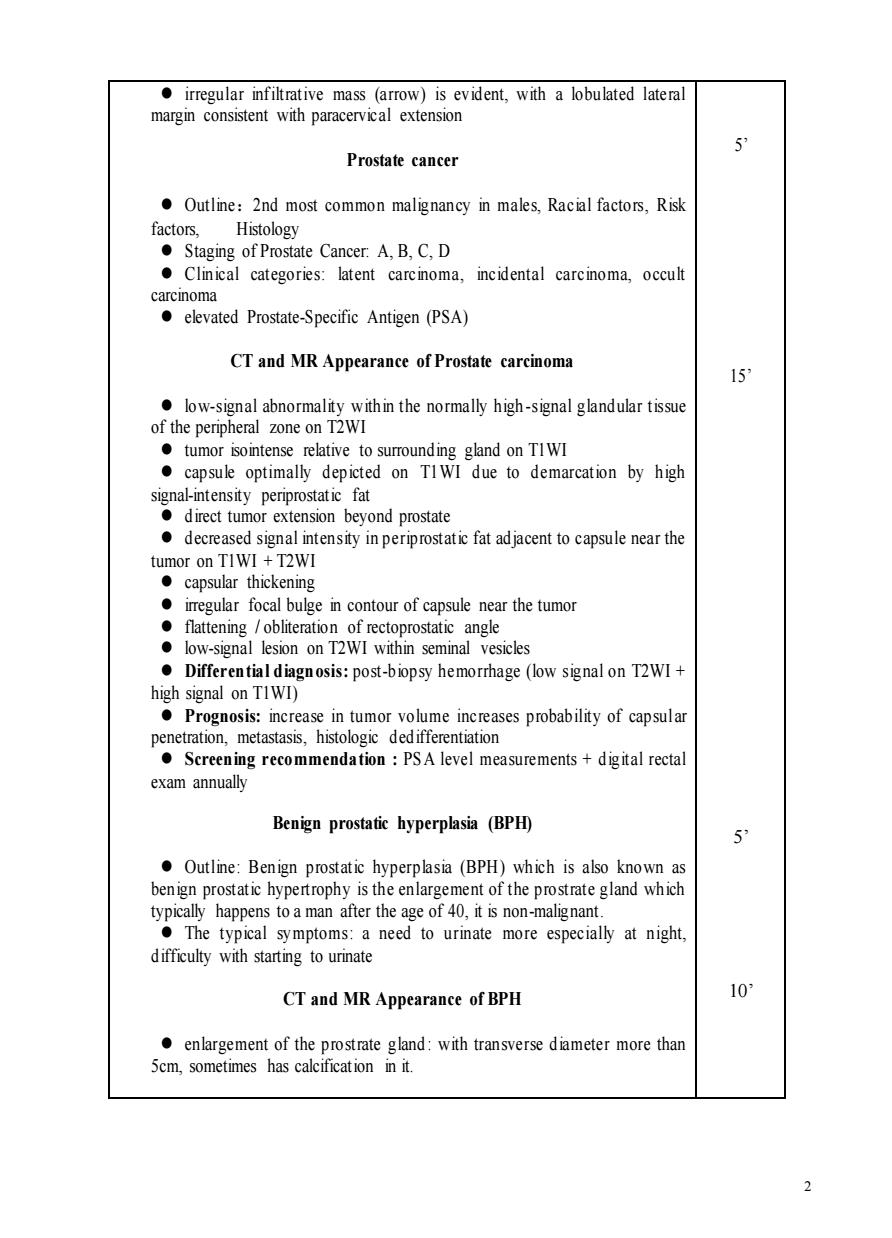正在加载图片...

irregular infiltrative mass (arrow)is evident,with a lobulated lateral margin consistent with paracervical extension Prostate cancer Outline:2nd most common malignancy in males,Racial factors,Risk factors, Histology Staging of Prostate Cancer.A,B,C.D Clinical categories:latent carcinoma,incidental carcinoma,occult carcinoma elevated Prostate-Specific Antigen(PSA) CT and MR Appearance of Prostate carcinoma 15 low-signal abnormality within the normally high-signal glandular tissue of the peripheral zone on T2WI tumor isointense relative to surrounding gland on TIWI capsule optimally depicted on TIWI due to demarcation by high signal-intensity periprostatic fat direct tumor extension bev ond prostate decreased signal intensity in periposta fat adjacent tocapsule near the rIWI+T2WI capsula ning irregular focal bulge in contour of capsule near the tumor flattening /obliteration of rectoprostatic angle low-signal lesion on T2WI within seminal vesicles Differential diagnosis:post-biopsy hemorrhage (low signal on T2WI+ high signal on TIWI) Prognosis:increase in tumor volume increases probability of capsula penetration,metastasis, Scre enin :PSA level measurements+digital rectal exam annually Benign prostatic hyperplasia (BPH) 5 Outline:Benign prostatic hyperplasia(BPH)which is also known as benign prostatic hypertrophy is the enlargement of the prostrate gland which typically happens to a man after the age of 40,it is non-malignant. The typical symptoms:a need to urinate more especially at night difficulty with starting to urinate CT and MR Appearance of BPH 10 22 ⚫ irregular infiltrative mass (arrow) is evident, with a lobulated lateral margin consistent with paracervical extension Prostate cancer ⚫ Outline:2nd most common malignancy in males, Racial factors, Risk factors, Histology ⚫ Staging of Prostate Cancer: A, B, C, D ⚫ Clinical categories: latent carcinoma, incidental carcinoma, occult carcinoma ⚫ elevated Prostate-Specific Antigen (PSA) CT and MR Appearance of Prostate carcinoma ⚫ low-signal abnormality within the normally high -signal glandular tissue of the peripheral zone on T2WI ⚫ tumor isointense relative to surrounding gland on T1WI ⚫ capsule optimally depicted on T1WI due to demarcation by high signal-intensity periprostatic fat ⚫ direct tumor extension beyond prostate ⚫ decreased signal intensity in periprostatic fat adjacent to capsule near the tumor on T1WI + T2WI ⚫ capsular thickening ⚫ irregular focal bulge in contour of capsule near the tumor ⚫ flattening / obliteration of rectoprostatic angle ⚫ low-signal lesion on T2WI within seminal vesicles ⚫ Differential diagnosis: post-biopsy hemorrhage (low signal on T2WI + high signal on T1WI) ⚫ Prognosis: increase in tumor volume increases probability of capsular penetration, metastasis, histologic dedifferentiation ⚫ Screening recommendation : PSA level measurements + digital rectal exam annually Benign prostatic hyperplasia (BPH) ⚫ Outline: Benign prostatic hyperplasia (BPH) which is also known as benign prostatic hypertrophy is the enlargement of the prostrate gland which typically happens to a man after the age of 40, it is non-malignant. ⚫ The typical symptoms: a need to urinate more especially at night, difficulty with starting to urinate CT and MR Appearance of BPH ⚫ enlargement of the prostrate gland : with transverse diameter more than 5cm, sometimes has calcification in it. 5’ 15’ 5’ 10’